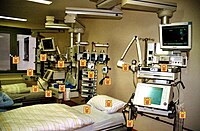
Photo from wikipedia
Vancomycin-resistant enterococci (VRE) can rapidly spread through hospitals. Therefore, our hospital employs a screening program whereby rectal swabs are screened for the presence of vanA and vanB, and only PCR-positive… Click to show full abstract
Vancomycin-resistant enterococci (VRE) can rapidly spread through hospitals. Therefore, our hospital employs a screening program whereby rectal swabs are screened for the presence of vanA and vanB, and only PCR-positive broths are cultured on VRE selection agar. Early November 2016, a clinical vanA-/vanB-negative VRE isolate was detected in a vanA/vanB-screening-negative patient, giving the possibility that an undetected VRE might be spreading within our hospital. Whole-genome-sequencing of the isolate showed that resistance was vanD-mediated and core genome multilocus sequence typing showed it was a rare type: ST17/CT154. To determine the prevalence of vanA/B/C/D-carrying enterococci, we designed a real-time PCR for vanC1/2/3 and vanD and screened rectal swabs from 360 patients. vanD was found in 27.8% of the patients, yet culture demonstrated only E. faecium from vanA-positive broths and E. gallinarum from vanC1-positive broths. No vanD-positive VRE were found, limiting the possibility of nosocomial spread of this VRE. Moreover, the high prevalence of non-VRE vanD in rectal swabs makes it unfeasible to include the vanD PCR in our VRE screening. However, having validated the vanC1/2/3 and vanD PCRs allows us to rapidly check future vanA/B-negative VRE for the presence of vanC and vanD genes.
Journal Title: Scientific Reports
Year Published: 2019
Link to full text (if available)
Share on Social Media: Sign Up to like & get
recommendations!